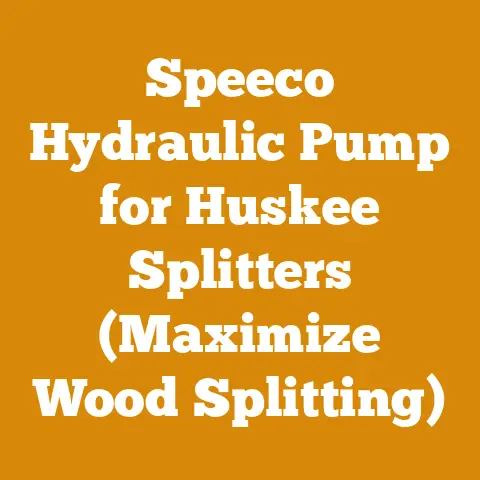Tar Fence Posts: Benefits of Cement-Covered Wood (3 Proven Tips)
Layering, like the rings of a tree, represents the accumulation of knowledge and experience.
In the world of wood processing and firewood preparation, layering also brings up the concept of protection – specifically, the protection afforded by tar and cement to wooden fence posts.
While seemingly simple, the longevity of a fence hinges on the durability of its posts.
That’s where understanding the benefits of tar-and-cement-covered wood becomes crucial.
Having spent years in and around logging operations and firewood businesses, I’ve seen firsthand how proper preparation and protection can dramatically extend the lifespan of wooden structures.
In this article, I’ll share three proven tips for using tar and cement to protect your fence posts, turning a potentially short-term investment into a lasting one.
I’ll also delve into the crucial project metrics that will help you optimize your wood processing and firewood preparation efforts.
Tar Fence Posts: Benefits of Cement-Covered Wood (3 Proven Tips)
Building a sturdy, long-lasting fence isn’t just about aesthetics; it’s about making a sound investment.
Wooden fence posts, while aesthetically pleasing and often more affordable than metal alternatives, are susceptible to rot, insect damage, and the elements.
Treating them with tar and encasing the critical ground-contact area in cement offers a robust defense.
Let’s explore these proven tips and the project metrics that underscore their importance.
Tip 1: The Right Tar Application for Superior Protection
Why Tar? Tar, or more accurately, bitumen-based coatings, acts as a water-resistant barrier.
Water is the enemy of wood, as it creates the perfect environment for fungal growth, the primary cause of rot.
Tar also helps to repel insects that can burrow into the wood and weaken its structural integrity.
How to Apply:
- Preparation is Key: Ensure the wood is dry and free of loose bark or debris.
I typically use a wire brush to clean the area that will be buried in the ground, plus a few inches above. - Heating the Tar (Safely!): Follow the manufacturer’s instructions for heating the tar.
Never overheat it, as this can cause dangerous fumes and even fire.
A double boiler setup or a specialized tar kettle is ideal.
Safety glasses and gloves are absolutely essential. - Application: Using a brush or roller, apply a generous coat of tar to the portion of the post that will be underground and extending several inches above the anticipated ground line.
This is critical – the area just above the ground is where moisture tends to accumulate.
Ensure complete coverage. - Curing Time: Allow the tar to cure completely according to the manufacturer’s instructions before proceeding to the cement encasement.
Project Metrics to Track:
- Tar Coverage Uniformity (TCU):
- Definition: A subjective measure of how evenly the tar is applied to the wood surface.
- Importance: Uneven coverage leaves vulnerable spots where moisture and insects can penetrate.
- Interpretation: I rate TCU on a scale of 1 to 5, with 5 being perfectly uniform.
Anything below a 4 requires a reapplication to thin spots. - Relationship to Other Metrics: Directly impacts Post Longevity Estimate (PLE), discussed later.
- Tar Consumption Rate (TCR):
- Definition: The amount of tar used per fence post (e.g., liters per post).
- Importance: Helps to estimate material costs for future projects and identify potential over- or under-application.
- Interpretation: Track the average TCR over several posts.
A sudden increase could indicate a change in tar viscosity or application technique.
I aim for a TCR of approximately 0.5 liters per standard 4×4 post. - Relationship to Other Metrics: Affects Overall Project Cost (OPC).
Personal Story: I remember one project where we skimped on the tar to save money.
Within three years, those posts were showing signs of rot.
The cost of replacing them far outweighed the initial savings on the tar.
It was a painful lesson in the importance of proper preparation and material application.
Tip 2: Cement Encasement for Enhanced Stability and Protection
Why Cement? The cement encasement provides a physical barrier against moisture and insects, further protecting the tarred wood.
It also adds significant stability to the post, preventing it from shifting in the ground due to frost heave or wind pressure.
Think of it as a reinforced shield.
How to Encase:
- Digging the Hole: Dig a hole that is wide enough to accommodate the post and at least 4-6 inches of cement around it.
The depth will depend on your local frost line and soil conditions.
Generally, a depth of 2-3 feet is sufficient in many regions. - Positioning the Post: Place the tarred post in the center of the hole, ensuring it is plumb (perfectly vertical).
Use temporary braces to hold it in place. - Mixing the Cement: Prepare the cement according to the manufacturer’s instructions.
I prefer using a pre-mixed concrete mix for consistency.
Add water gradually until you achieve a workable consistency – not too soupy, not too dry. - Pouring the Cement: Carefully pour the cement around the post, filling the hole to ground level.
Use a trowel or shovel to compact the cement and remove any air pockets. - Finishing: Slope the top of the cement away from the post to encourage water runoff.
This prevents water from pooling at the base of the post, which can still lead to rot over time.
Project Metrics to Track:
- Cement-to-Post Gap (CPG):
- Definition: The average distance between the post and the edge of the cement encasement.
- Importance: A consistent gap ensures uniform support and prevents stress concentrations.
- Interpretation: I measure the CPG at multiple points around the post.
A significant variation indicates an uneven pour or shifting of the post during the curing process.
I aim for a CPG of 4-6 inches. - Relationship to Other Metrics: Affects Post Stability Index (PSI).
- Cement Curing Time (CCT):
- Definition: The time it takes for the cement to reach its full strength.
- Importance: Premature stress on uncured cement can lead to cracking and weakening.
- Interpretation: Adhere strictly to the cement manufacturer’s recommended curing time, typically 28 days.
Track the date of the pour and the estimated completion of curing. - Relationship to Other Metrics: Impacts Post Stability Index (PSI) and Post Longevity Estimate (PLE).
- Cement Mix Ratio (CMR):
- Definition: The proportion of cement, sand, and aggregate used in the concrete mix (e.g., 1:2:4).
- Importance: The correct CMR is critical for achieving the desired strength and durability of the concrete.
- Interpretation: Use a pre-mixed concrete bag to ensure the correct CMR.
If mixing your own, carefully measure the ingredients using a calibrated scale. - Relationship to Other Metrics: Directly impacts Post Stability Index (PSI).
Case Study: A local farmer used a cement mix with an incorrect CMR.
The resulting encasement was weak and crumbly.
Within a few years, the posts were leaning, and the fence needed significant repairs.
This highlights the importance of using the correct materials and following instructions carefully.
Tip 3: Wood Selection and Pre-Treatment for Maximum Longevity
Why Wood Selection Matters: Not all wood is created equal.
Some species are naturally more resistant to rot and insect damage than others.
Choosing the right wood is the first step in building a long-lasting fence.
Pre-Treatment Options: Even naturally durable woods can benefit from pre-treatment.
Pressure-treated lumber is an excellent option, but it can be more expensive.
Another option is to apply a wood preservative to the portion of the post that will be buried in the ground.
How to Select and Treat:
- Choose the Right Species: Consider using naturally rot-resistant woods such as cedar, redwood, black locust, or osage orange.
These woods contain natural oils and compounds that deter insects and fungi. - Consider Pressure-Treated Lumber: Pressure-treated lumber is impregnated with chemicals that make it highly resistant to rot and insects.
This is a good option if you are using a less durable wood species. - Apply a Wood Preservative: If you are not using pressure-treated lumber, apply a wood preservative to the portion of the post that will be buried in the ground.
Follow the manufacturer’s instructions carefully. - Seasoning the Wood: Allow the wood to season properly before installation.
Seasoning reduces the moisture content of the wood, making it less susceptible to rot.
Project Metrics to Track:
- Wood Species Durability Rating (WSDR):
- Definition: A rating of the wood’s natural resistance to rot and insect damage.
- Importance: Helps to select the most appropriate wood species for the project.
- Interpretation: Consult wood durability charts and resources to determine the WSDR for different wood species.
I use a scale of 1 to 5, with 5 being the most durable. - Relationship to Other Metrics: Directly impacts Post Longevity Estimate (PLE).
- Wood Moisture Content (WMC):
- Definition: The percentage of water in the wood.
- Importance: High moisture content promotes rot and insect infestation.
- Interpretation: Use a moisture meter to measure the WMC.
Aim for a WMC below 20% before installation.
Track WMC over time to monitor seasoning progress. - Relationship to Other Metrics: Impacts Tar Adhesion Strength (TAS) and Post Longevity Estimate (PLE).
- Preservative Absorption Rate (PAR): (If applicable)
- Definition: The amount of preservative absorbed by the wood.
- Importance: Adequate absorption ensures effective protection.
- Interpretation: Follow the preservative manufacturer’s instructions for application rates.
Monitor the amount of preservative used per post and compare it to the recommended rate. - Relationship to Other Metrics: Impacts Post Longevity Estimate (PLE).
Insight from the Field: I once used improperly seasoned wood for a fence project.
Despite careful tarring and cement encasement, the posts began to rot within a few years.
The high moisture content created a breeding ground for fungi.
This experience taught me the importance of properly seasoning wood before installation.
- Overall Project Cost (OPC):
- Definition: The total cost of the project, including materials, labor, and equipment.
- Importance: Helps to track expenses and identify areas for cost reduction.
- Interpretation: Track all project costs meticulously.
Compare OPC to the estimated budget and analyze any discrepancies. - Relationship to Other Metrics: Affected by Tar Consumption Rate (TCR), Cement Mix Ratio (CMR), and Wood Species Durability Rating (WSDR).
- Labor Hours per Post (LHP):
- Definition: The number of labor hours required to install one fence post.
- Importance: Helps to estimate labor costs for future projects and identify areas for improving efficiency.
- Interpretation: Track the time spent on each post installation.
Analyze the data to identify bottlenecks and areas where labor can be optimized. - Relationship to Other Metrics: Affects Overall Project Cost (OPC).
- Post Stability Index (PSI):
- Definition: A measure of the post’s resistance to movement and leaning.
- Importance: Indicates the structural integrity of the fence.
- Interpretation: Regularly inspect the posts for signs of leaning or movement.
Use a plumb bob or level to measure the angle of the post.
Track changes in PSI over time. - Relationship to Other Metrics: Affected by Cement-to-Post Gap (CPG) and Cement Curing Time (CCT).
- Post Longevity Estimate (PLE):
- Definition: An estimate of the post’s expected lifespan.
- Importance: Helps to assess the long-term value of the project.
- Interpretation: Based on historical data, wood species durability ratings, and the quality of the tar and cement application.
Regularly inspect the posts for signs of deterioration and adjust the PLE accordingly. - Relationship to Other Metrics: Affected by Tar Coverage Uniformity (TCU), Wood Species Durability Rating (WSDR), and Wood Moisture Content (WMC).
- Waste Material Percentage (WMP):
- Definition: The percentage of materials wasted during the project (e.g., excess cement mix).
- Importance: Highlights inefficiencies in material usage and potential cost savings.
- Interpretation: Track the amount of waste generated during the project.
Analyze the data to identify the causes of waste and implement measures to reduce it. - Relationship to Other Metrics: Directly impacts Overall Project Cost (OPC).
Addressing Challenges Faced by Small-Scale Loggers and Firewood Suppliers
Many small-scale loggers and firewood suppliers face unique challenges, including limited access to resources, fluctuating market prices, and the need to balance cost-effectiveness with quality.
Implementing these tarring and cementing techniques can be particularly beneficial for these individuals because:
- Extending Post Lifespan Reduces Replacement Costs: For those operating on tight margins, minimizing replacement costs is crucial.
Properly treated posts can last significantly longer, reducing the financial burden of frequent repairs. - Using Locally Sourced Materials: In many regions, small-scale operators rely on locally sourced wood.
While these woods may not always be the most durable, proper treatment can significantly extend their lifespan. - Improved Efficiency: By tracking key metrics like Labor Hours per Post (LHP) and Waste Material Percentage (WMP), small-scale operators can identify areas for improving efficiency and maximizing their profits.
A Global Perspective: I’ve observed similar challenges in various regions around the world.
Whether it’s a small farmer in rural India or a firewood supplier in Eastern Europe, the need for cost-effective and durable solutions is universal.
The principles of proper wood treatment and cement encasement apply regardless of location.
Applying These Metrics to Improve Future Projects
Tracking and analyzing these metrics is not just about measuring past performance; it’s about improving future projects.
Here’s how you can apply these insights:
- Create a Project Database: Maintain a database of all your fence-building projects, including the metrics you tracked.
This will allow you to compare performance across different projects and identify trends. - Identify Areas for Improvement: Analyze the data to identify areas where you can improve efficiency, reduce costs, and enhance the quality of your work.
- Set Realistic Goals: Use the data to set realistic goals for future projects.
For example, if you consistently achieve a Labor Hours per Post (LHP) of 2 hours, aim to reduce it to 1.75 hours on your next project. - Experiment and Iterate: Don’t be afraid to experiment with different techniques and materials.
Track the results and adjust your approach accordingly. - Continuous Learning: Stay up-to-date on the latest advancements in wood preservation and construction techniques.
Attend workshops, read industry publications, and network with other professionals.
Conclusion
Protecting your fence posts with tar and cement is an investment in the long-term durability and stability of your fence.
By following these three proven tips – proper tar application, cement encasement, and wood selection and pre-treatment – you can significantly extend the lifespan of your fence posts and reduce the need for costly repairs.
But the real key to success lies in tracking and analyzing the right project metrics.
By understanding how these metrics relate to each other and using them to inform your decisions, you can optimize your wood processing and firewood preparation efforts, improve efficiency, and maximize your profits.
Remember, knowledge, like the rings of a tree, grows with time and experience.
Embrace the power of data-driven decision-making, and your fence-building projects will stand the test of time.






